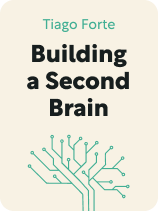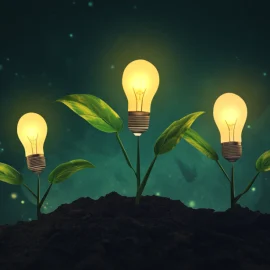

This article is an excerpt from the Shortform book guide to "Building a Second Brain" by Tiago Forte. Shortform has the world's best summaries and analyses of books you should be reading.
Like this article? Sign up for a free trial here.
What is the book Building a Second Brain by Tiago Forte about? What are the main takeaways of the book?
In Building a Second Brain, Tiago Forte recommends storing valuable information in a digital store center that he calls a “Second Brain.” His book discusses the benefits of using a Second Brain, how to build one, and how to use one to maximize your productive and creative potential.
Read below for a brief overview of the Building a Second Brain book.
Building a Second Brain by Tiago Forte
In today’s age of technology, we’re constantly surrounded by important information. However, our brains aren’t equipped to effectively process and recall every important thing we encounter, leaving us frustrated and overwhelmed. Consequently, many people feel like they’re failing to reach their full potential—as if they’re dying of thirst during a rainstorm simply because they lack the means to capture what’s surrounding them.
Luckily, in the Building a Second Brain book, Tiago Forte presents a solution to this problem—a straightforward method of recording, organizing, and utilizing valuable information. This method allows you to recall important knowledge at the snap of your fingers, easily connect ideas and make discoveries, and complete any goal or project to the best of your ability.
Forte specializes in productivity and the emerging field of personal knowledge management (PKM). He’s also the founder of Forte Labs, a consulting firm that helps organizations improve productivity and maximize creative potential through the principles and techniques of design thinking. Alongside Building a Second Brain, Forte has also published four shorter books—Design Your Work, Extend Your Mind, The Heart is the Bottleneck, and Ways of Knowing—as part of the Praxis series. In this series, he uses his personal experiences to teach others about the nature of knowledge, productivity, and creativity.
In Building a Second Brain, Forte explains how you can create an external storage system of knowledge (that he calls a “Second Brain”) and why doing so is important. In this guide, we’ll discuss the benefits of an external information storage system, how to effectively organize this system and store information, and how to use your storage system to maximize your productivity and creative potential. We’ll also discuss alternative note-taking methods, organizational systems, and techniques that can improve your productivity, citing books like The Effective Executive by Peter Drucker and Getting Things Done by David Allen.
Your Brain’s Not Equipped to Effectively Manage Today’s Information
Forte claims that modern humans need an external storage system (ESS)—a digital platform to store all the important ideas, information, and work they encounter—because knowledge, and the ability to do knowledge work, is the most valued asset in today’s society. In Forte’s view, knowledge work involves recalling important pieces of information, making connections between them, and using the insights gained from this process to develop novel ideas or solve problems. Your ability to do knowledge work hinges on how creative and productive you are. Creativity is the ability to make connections between ideas and information. Productivity is the ability to make effective use of your time and creativity to accomplish a goal. The more creative connections you can make, and the faster you can execute on them, the better you’ll be at knowledge work.
However, Forte notes that our ability to do knowledge work is hindered by our brain’s inability to effectively manage today’s information. We have access to an unlimited amount of important information in today’s modern age due to the rapid evolution of technology. However, our brains can’t store and recall this vast quantity of information because they haven’t developed at the same exponential rate. Consequently, we struggle to remember important information when we need it, which hampers our ability to do knowledge work.
A digital external storage system solves this problem by allowing us to store every important idea we encounter in a highly organized system that makes it easy to recall information at any time. This will increase our creativity (ability to draw connections between ideas) and productivity (ability to quickly recall information), which, in turn, will increase our knowledge and ability to do knowledge work.
How To Organize Your Storage System
Forte explains that the organization of your external storage system is the most important component of increasing your creativity and productivity. Creating folders and sub-folders in your digital storage system will allow you to easily locate and utilize saved information.
(Shortform note: While Forte says that the highly organized digital working environment of an ESS will increase productivity and creativity, recent studies on physical working environments suggest that this may not be the case. Psychologists found no difference in productivity between people working in organized environments and those working in cluttered ones. However, the people in cluttered environments produced more unique and interesting ideas—they more creative. If the observations from this study on physical work environments hold true for digital work environments, then your creativity might benefit more from a more integrated or “cluttered” ESS, rather than a highly siloed one like Forte recommends.)
How to Effectively Use Your External Storage System
Once you’ve organized your external storage system, Forte explains that you must learn how to use it in a way that increases your productivity and creative potential. His process for utilizing your ESS mirrors the creative process, which he explains has two modes: expansion and contraction. (Forte calls these modes divergence and convergence, respectively.) First, you must expand the possibilities of a project or goal to include all relevant information and resources. Then, you must contract by narrowing your scope, cutting extra information, and refining your product or idea until you have a final result.
Forte explains that the first two steps of using your ESS are to record information and sort it into relevant folders where you can utilize it (these are the condense and organize steps of Forte’s CODE system for saving information). These steps are part of the expansion mode of the creative process—they’re designed to gather relevant information that gets your creative juices flowing and sparks new ideas.
The second two steps of using your ESS are to refine your notes to their most important parts and use them to create something (these are the distill and express steps of Forte’s CODE system). These steps are part of the contraction mode of the creative process—they’re designed to narrow the scope of your information and propel you toward the completion of your goals.

———End of Preview———
Like what you just read? Read the rest of the world's best book summary and analysis of Tiago Forte's "Building a Second Brain" at Shortform.
Here's what you'll find in our full Building a Second Brain summary:
- Why we get frustrated and overwhelmed in the age of information
- Why modern humans need an external storage system (ESS)
- How to make and organize an ESS to increase creativity and productivity






